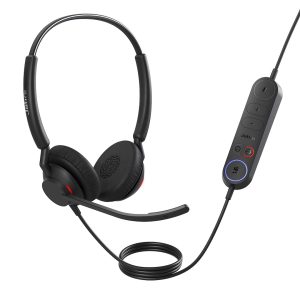With the variety of listening devices on the market and their multi-function capabilities to listen, speak, and call, it can be difficult to distinguish headsets from headphones. Though they are similar, there are key differences between the two popular listening devices. LearningAboutElectronics.com defines headsets as “a pair of headphones with a microphone attached.” Because headphones are an essential aspect of them, headsets typically go over the ear and have the same functionality that headphones do. The prominent microphone differentiates headsets from headphones, often manifested as a boom extending to the front of a user’s mouth for ease of use and communication.
ResearchandMarkets.com reports that the Global Headset Market is projected to reach $76.83 billion in 2023, up from $58.70 billion in 2022. For this two-year period, the compound annual growth rate (CAGR), or the rate of return required for an investment to increase from its beginning to its ending balance, is 30.9 percent. The growth does not stop there. By 2027, the value of the Global Headset Market is charted to reach a whopping $224.92 billion.
With so many options to choose from and the market indicating that headsets are only increasing in value, retailers must stay up to date on headset types and trends that are driving growth, which can help discern which headset is the right fit for customers and clients.
Types of Headsets Influencing Market Growth
Like any listening device today, headsets come in various designs and are accompanied by a litany of features. Some headsets even come in the boom-less variety. However, the main types of headsets that are driving the growth of the global headset market include:
- Closed-back: headsets with headphones completely sealed in the back. The sound emitted from these headsets can only come from the section closest to the ears. They are especially useful for users who want an isolated sound experience but not a natural-feeling one.
- Open-back: headsets with headphones that allow air to pass through the ear cups, meaning that “resonances and low-frequency build-ups caused by the rear enclosure aren’t a concern,” according to Soundguys.com. Users who desire a high-quality listening experience with their headsets should seek open-back ones but leave them at home if they use them in a louder environment like a call center or a warehouse.
- Active noise-canceling: headsets with active noise cancelation (ANC) technology. Hearlife.org outlines the science of ANC as using microphones “to detect incoming sound in the environment, and then generate the inverse wave” to ‘cancel’ the incoming sound wave.
Telecommunication and Headsets
Headsets’ compatibility with various devices like smartphones and PCs and their applicability to myriad situations like taking customer service calls and gaming tournaments make them a hot commodity.
A driver of the global market growth of headsets seems to be smartphones. ResearchandMarkets.com indicates that as smartphones have become more commonplace worldwide, compatible headsets have adapted as well. Headsets are often used in situations and environments like call centers or IT, where users need to listen and communicate hands-free.
Headsets to Watch: Jabra’s Engage 40 and Engage 50 II
Several brands are making headway in the Global Headset Market. Two headsets that have stood out in the ResearchandMarket.com projections are from Denmark-based audio equipment company Jabra. These headsets are the Engage 40 and Engage 50 II, digital headsets launched in September 2022.

Jabra Engage 40
With the Jabra Engage 40 headset, users get a lightweight headset designed with comfort in mind. The ear cups have angled cushions designed with a maze pattern to relieve ear pressure while adapting to the specific user’s ears.
The Jabra Engage 40 has a microphone boom containing two microphones, each performing a separate function: one has noise-canceling capability, while the other ensures a user’s voice remains crystal clear, especially in tasks requiring speech-to-text.
It also comes with an inline control unit with programmable buttons. The unit allows the user to adjust the volume, mute, and answer calls. It can also be integrated with contact centers and Unified Communications (UC) platforms.

Jabra Engage 50 II
Like the Engage 40, the Jabra Engage 50 II maintains comfortability and functionality. The Engage 50 II comes with two ear cups, each with the signature Jabra maze pattern.
What distinguishes the Engage 50 II from the Engage 40 are the triple microphone system and SmartRinger technology. The triple microphone system performs ANC and ensures clear communication and accurate transcription. SmartRinger, built into the programmable inline control unit on the Engage 50 II, alerts headset owners of an incoming call when the headset is off and lying on a flat surface. Its headband also comes with padding to optimize comfort and wearability.















